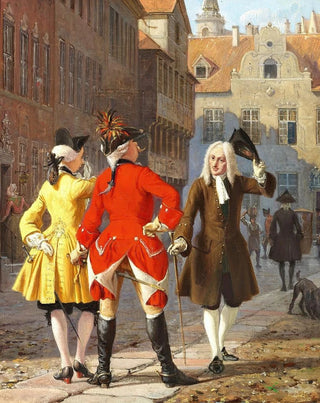Art print | Jacob contre Thybo et Jean de France - Wilhelm Marstrand


View from behind

Frame (optional)
Introduction captivante
Plunging into the intricacies of art history, Wilhelm Marstrand's "Jacob contre Thybo et Jean de France" stands out as an iconic masterpiece of the 19th century. This painting, depicting a dramatic and emotionally charged scene, invites viewers to explore internal conflicts and power struggles that have marked history. By highlighting a confrontation between historical figures, Marstrand succeeds in capturing not only the intensity of the moment but also the complexity of human relationships. The art print of Jacob contre Thybo et Jean de France - Wilhelm Marstrand thus presents a true mirror of the human soul, revealing passions and tensions that inhabit its characters.
Style and uniqueness of the work
Wilhelm Marstrand's style is characterized by an exceptional mastery of colors and forms, which bring his compositions to life. In "Jacob contre Thybo et Jean de France," the artist employs a rich and nuanced palette, where shadows and lights blend to create an atmosphere that is both dramatic and captivating. The expressions of the characters, finely detailed, demonstrate profound realism, making each face unique and full of story. Marstrand manages to establish a visual dialogue between the protagonists, where each gesture and gaze seem to carry a broader narrative. This ability to capture human emotion in all its complexity gives the artwork a timeless dimension, allowing viewers to project themselves into it and feel the palpable tension emanating from it.
The artist and his influence
Wilhelm Marstrand, a key figure in 19th-century Danish art, established himself as a master in the field of historical painting. Trained at the Royal Danish Academy of Fine Arts in Copenhagen, he was influenced by great European masters while developing a style that is uniquely his own. His works, often inspired by biblical or historical stories, reflect deep contemplation on the human condition. Marstrand combined impeccable technique with artistic sensitivity, enabling him to reach a broad audience. His influence endures today, both within artistic circles and in the way

Matte finish

View from behind

Frame (optional)
Introduction captivante
Plunging into the intricacies of art history, Wilhelm Marstrand's "Jacob contre Thybo et Jean de France" stands out as an iconic masterpiece of the 19th century. This painting, depicting a dramatic and emotionally charged scene, invites viewers to explore internal conflicts and power struggles that have marked history. By highlighting a confrontation between historical figures, Marstrand succeeds in capturing not only the intensity of the moment but also the complexity of human relationships. The art print of Jacob contre Thybo et Jean de France - Wilhelm Marstrand thus presents a true mirror of the human soul, revealing passions and tensions that inhabit its characters.
Style and uniqueness of the work
Wilhelm Marstrand's style is characterized by an exceptional mastery of colors and forms, which bring his compositions to life. In "Jacob contre Thybo et Jean de France," the artist employs a rich and nuanced palette, where shadows and lights blend to create an atmosphere that is both dramatic and captivating. The expressions of the characters, finely detailed, demonstrate profound realism, making each face unique and full of story. Marstrand manages to establish a visual dialogue between the protagonists, where each gesture and gaze seem to carry a broader narrative. This ability to capture human emotion in all its complexity gives the artwork a timeless dimension, allowing viewers to project themselves into it and feel the palpable tension emanating from it.
The artist and his influence
Wilhelm Marstrand, a key figure in 19th-century Danish art, established himself as a master in the field of historical painting. Trained at the Royal Danish Academy of Fine Arts in Copenhagen, he was influenced by great European masters while developing a style that is uniquely his own. His works, often inspired by biblical or historical stories, reflect deep contemplation on the human condition. Marstrand combined impeccable technique with artistic sensitivity, enabling him to reach a broad audience. His influence endures today, both within artistic circles and in the way






